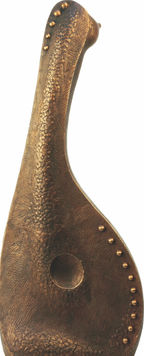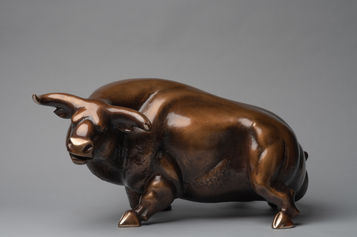mike renard
“I do not remember when I was in one place for more than 3 weeks — I am the ‘Man of the Universe!’” explains Mike Renard, whose determined mobility across the globe is vividly manifested in his three-dimensional work. He finds inspiration in beauty and composure, as well as collapse and despair that prevail our contemporary landscape, in disparate corners of the universe, which the human condition duplicates.”
Mobility is equally crucial for viewers of his arresting bronze sculptures, which reveal their complete identities only after a full journey encompasses them. “It is the other side that creates the mystery and intrigue that excites interest, and evokes the answer for what the sculptor wanted to say and express,” he explains.
The Big
23x39x29in
59x99x73cm
The Big is a sculptural interpretation about the fragility of life. Despite the size of the dinosaur and elephant, these two enormous earthly creatures, one is gone from a massive extinction and the other barely exists in a global environment that is precipitating a similar fate. The juxtaposition of the dinosaur and elephant in this sculpture makes a profound statement about the importance of respecting wildlife and preserving a species that play an important role in our natural environment before they become extinct."
Rhino Beetle
12x21x12in
31x54x30cm
A sculptural depiction of the fragility of our environment, where both small and large scale life forms are in danger of extinction.
CrabBird
14x15x12.6in
36x38x32cm
A statement of a natural interdependence, where one of life’s creations flies freely across the skies as another crawls on the ocean’s floor, each ultimately relying on each to sustain survival.
Symphony
28x12x7.5in
72x30x19cm


A composition of life that merges the visually flowing curves of a female form with the harmonious and sensual sounds of a traditional Ukrainian musical instrument, the “bandura.”
La Piovra
8x16x15in
21x41x38 cm
A work intended to be a social comment about corruption. Titled after the Italian word for “octopus,” it is a slang term often used for organized crime, and the seven tentacles represent Christianity’s “Seven Deadly Sins.” In the artwork’s alternative view, corruptive money is often referred to as “cabbage.”
Don’t Miss
12.6x7x6.3in
32x18x16cm
An anamorphic form that interprets the intensive impulses of both an owl and a boxer, which spot the prey, then relentlessly attack it.
RattleNozzle
27x15.7x12.2in
69x40x31cm
An interpretive view of the slithering, underlying influence and environmental perils of fossil fuels on human and animal populations worldwide.
Rich Yorick
7.5x9x5.5in
19x23x14cm


In Shakespeare's Hamlet the constant brooding about death and humanity is grotesquely portrayed in the infamous graveyard scene where Hamlet holds up the unearthed skull of poor Yorick, that itself is a physical reminder of the inevitability and finality of death.
The Pigs head in Rich Yorick symbolizes the pervasive ever-present greed while alive that is juxtaposed with humanities shared fate that things of life are inconsequential death.
Banana Republic
8.7x6.7x14in
22x17x36cm


This term was first used in 1904 by the American writer O. Henry to describe life in a corrupt and politically unstable country. In this artwork, the “corn” represents a nation of people, and its nonsensical outer cornhusk depicts a corruptive layer that needs to peeled-away for the people to be freed from authoritative greed.
Bull and bear
12.6 in x 24.8 in x 16.5 in


Bull and Bear


















